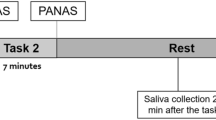Summary.
Background. Research on basal HPA axis activity in patients with panic disorder showed inconsistent results.
Methods. Basal total plasma, plasma free and salivary cortisol levels were compared in patients with panic disorder (n = 47) and in healthy individuals (n = 23). Correlations between these fractions were calculated.
Results. All three basal cortisol fractions were significantly elevated in patients compared to controls. There were significant correlations between all three cortisol fractions.
Conclusions. Nonsignificant differences between cortisol levels of patients and healthy controls in previous studies may have been due to inclusion of less severely ill patients or to small sample sizes (96 words).
Similar content being viewed by others
Author information
Authors and Affiliations
Additional information
Received July 28, 1999; accepted October 26, 1999
Rights and permissions
About this article
Cite this article
Wedekind, D., Bandelow, B., Broocks, A. et al. Salivary, total plasma and plasma free cortisol in panic disorder. J Neural Transm 107, 831–837 (2000). https://doi.org/10.1007/s007020070062
Published:
Issue Date:
DOI: https://doi.org/10.1007/s007020070062




